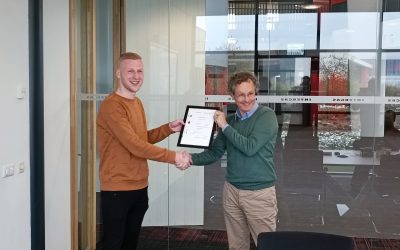Sensire opts for Lean: creating value with customer focus
Often conversations about Lean involve terms such as efficiency, reduce and minimize. Not so at health care organization Sensire. “It is a misconception that Lean only stands for those terms. We chose Lean precisely because Lean takes the customer need as the starting point.”
“As the largest healthcare organization in Achterhoek and the Liemers region, Sensire provides care, nursing and specialized care day and night, at people’s homes or in one of our residential care centers,” says Director of Operations (Finance, ICT, P&O) Marieke Bokkinga. “The Sensire Service Company of which I am director provides products and services in the areas of HR, but also Finance, ICT, Care Contracting and Real Estate. With a team of about 100 professionals, we strive to ensure that our 3,500 healthcare professionals, who provide care 24 hours a day 7 days a week, are ‘burdened’ as little as possible with non-core activities. In short, no fuss. They are there for our clients, we are there for them.”
Lean for customer-oriented work
Sensire realizes this through innovation, optimization, digitalization, pragmatism, creativity, a healthy dose of drive and guts. “We always keep an eye out for each other and act based on common farm sense. Given the dynamics in the market, we realize that we will always remain a learning organization, that it is never finished and that things can always be done better or smarter. This is why Lean is so interesting to us. Why? Because with Lean you not only work smarter and more efficiently, but also very customer-oriented. And that is what really matters to us. In the case of the twenty HR employees who took Symbol’s training courses, those customers are our colleagues in the field.”
General knowledge, specifically applicable
“We ended up with a multi-day Lean Green Belt training pretty quickly,” Bokkinga continues. “For those trainings, we split into two groups, which we also use within HR: ‘Team district care’ and ‘Team living with care (nursing home care)’. That way we could learn even more from each other in the training, because you all recognize examples from your own direct working environment. Furthermore, we opted for a general rather than a care-specific training course. This meant that everyone gained a lot for his or her own personal development. Moreover, it turned out that this general knowledge can also be applied very specifically. We soaked up all the knowledge that trainer Daphne La Haye imparted to us like a sponge, so that we can now apply this knowledge effectively within our own work context. The pitfall with this kind of training is that after the training you allow yourself to be swallowed up by the issues of the day. You have to put the acquired knowledge into practice, otherwise the return on investment of the training is not high. It’s great to see that this is already happening.”
Week start signs: starting the conversation with each other
A great example of this is that all sub-teams within HR have recently started using weekly start-up boards. Bokkinga explains, “Each subteam put up a large white board in its own office and arranged it according to the principles of Lean. What needs to be done this week, which projects play in the longer term, what successes have we achieved this week and where can we improve? Employees already notice that their weekly starting board contributes to efficient consultation and better cooperation. They have a grip on who is doing what and what is going well and what is not. Agreements made also become clearer thanks to the weekly starting board, making it easier for colleagues to discuss what is not going well and why. With a better experience for our internal customers as a result, of course.”
Lean Green Belt Diploma
During the course, the desire grew among participants to even take the Lean Green Belt exam. “In the beginning everyone was excited, but the closer we got to the test moment the more reluctant we all became,” laughs Bokkinga. “However, we made the choice as a group to take the exam, and so we went for it as a group. And with success! I am super proud of ‘my’ HR cronies, because now we are all officially the proud bearer of a Lean Green Belt diploma.”
Better, not cheaper and faster
The follow-up path is also already clear to Bokkinga: “We will definitely continue with Lean. Daphne is currently helping various sub-teams to set up their processes correctly. For example, she is coaching a subteam on how to optimize the process related to hiring students (combo working/learning in care).” Finally, Bokkinga does have a tip for other organizations looking to get started with Lean. “It is a misconception that Lean only stands for cutting back and minimizing. We chose Lean, as I said, because with Lean the customer need is the starting point. We don’t want to work more efficiently because it has to be cheaper and faster, but because it makes it better. That can be a good starting point for more organizations or departments.”
Latest news/blogs
From Theory to Practice: Junior Consultant at Stoneridge
From theory to practice: Junior Consultant at Stoneridge Before working at Symbol, Junior...
Optimize Quality Management with AI Tools
Optimize quality management with AI tools In the modern business environment, quality management...
The Netherlands’ youngest Black Belt speaks
A ideal is not yet not a solutionEmiel recently gave a training session on the topic of problem...


